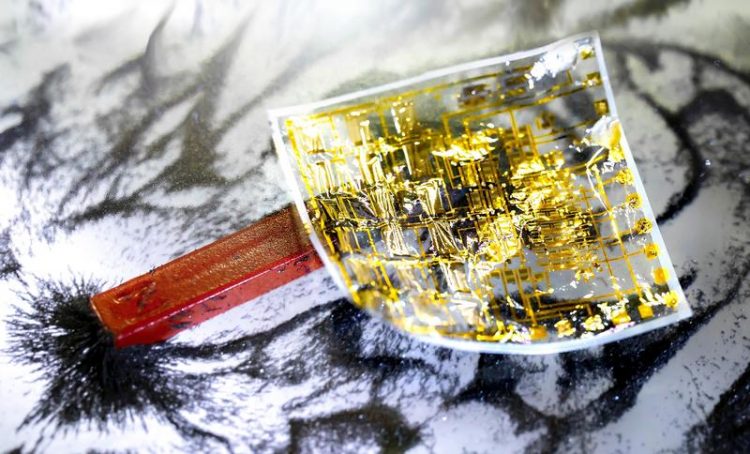Integrate Micro Chips for electronic Skin

Flexible electronic skin equipped with an array of giant magneto resistance sensors and complex electronics circuit designed and developed for sensing distribution of magnetic field. Photo: Masaya Kondo
Human skin is a fascinating and multifunctional organ with unique properties originating from its flexible and compliant nature. It allows for interfacing with external physical environment through numerous receptors interconnected with the nervous system.
Scientists have been trying to transfer these features to artificial skin for a long time, aiming at robotic applications. Operation of robotic systems heavily rely on electronic and magnetic field sensing functionalities required for positioning and orientation in space.
A lot of research and development have been devoted into implementation of these functionalities in a flexible and compliant form. The recent advancements in flexible sensors and organic electronics provided important prerequisites. These devices can operate on soft and elastic surfaces, whereas sensors perceive various physical properties and transmit them via readout circuits.
To closely replicate natural skin, it is however necessary to interconnect a big number of individual sensors. This challenging task became a major obstacle in realizing electronic skin. First demonstrations were based on an array of individual sensors addressed separately, which unavoidably resulted into a tremendous number of electronic connections.
In order to reduce the necessary wiring, an important technology step had to be done. Namely, complex electronic circuits, such as shift registers, amplifiers, current sources and switches must be combined with individual magnetic sensors to achieve fully integrated devices.
Researchers from Dresden, Chemnitz and Osaka could overcome this obstacle in a pioneering active matrix magnetic sensor system presented in a recent article of the journal Science Advances.
The sensor system consists of a 2 x 4 array of magnetic sensors, an organic bootstrap shift register, required for controlling the sensor matrix, and organic signal amplifiers. The special feature is that all electronic components are based on organic thin-film transistors and are integrated within a single platform.
The researchers demonstrate that the system has a high magnetic sensitivity and can acquire the two-dimensional magnetic field distribution in real time. It is also very robust against mechanical deformation, such as bending, creasing or kinking. In addition to full system integration, the use of organic bootstrap shift registers is a very important development step towards active matrix electronic skin for robotic and wearable applications.
Prof. Dr. Oliver G. Schmidt, Director at the Leibniz Institute for Solid State and Materials Research Dresden and Dr. Daniil Karnaushenko on the next steps: “Our first integrated magnetic functionalities prove that thin-film flexible magnetic sensors can be integrated within complex organic circuits.
Ultra-compliant and flexible nature of these devices is indispensable feature for modern and future applications such as soft-robotics, implants and prosthetics. The next step is to increase the number of sensors per surface area as well as to expand the electronic skin to fit larger surfaces.”
Prof. Dr. Oliver G. Schmidt, e-mail: o.schmidt@ifw-dresden.de, Phone 0049 351 4659 800
Dr. Daniil Karnaushenko e-mail: d.karnaushenko@ifw-dresden.de, Phone 0049 351 4659 766
Original publication: M. Kondo, M. Melzer, D. Karnaushenko, T. Uemura, S. Yoshimoto, M. Akiyama, Y. Noda, T. Araki, O. G. Schmidt, T. Sekitani, Imperceptible magnetic sensor matrix system integrated with organic driver and amplifier circuits, Sci. Adv. 2020; 6: eaay6094
Media Contact
All latest news from the category: Information Technology
Here you can find a summary of innovations in the fields of information and data processing and up-to-date developments on IT equipment and hardware.
This area covers topics such as IT services, IT architectures, IT management and telecommunications.
Newest articles

Superradiant atoms could push the boundaries of how precisely time can be measured
Superradiant atoms can help us measure time more precisely than ever. In a new study, researchers from the University of Copenhagen present a new method for measuring the time interval,…

Ion thermoelectric conversion devices for near room temperature
The electrode sheet of the thermoelectric device consists of ionic hydrogel, which is sandwiched between the electrodes to form, and the Prussian blue on the electrode undergoes a redox reaction…

Zap Energy achieves 37-million-degree temperatures in a compact device
New publication reports record electron temperatures for a small-scale, sheared-flow-stabilized Z-pinch fusion device. In the nine decades since humans first produced fusion reactions, only a few fusion technologies have demonstrated…





















